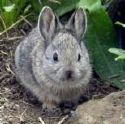Goodbye, Pygmy Rabbit--Or Not

This afternoon The Seattle Times announced the death of the last male pure bred Columbia Basin pygmy rabbit. According to the news account, "The tiny rabbits are found only in Douglas County in north-central Washington." No Columbia Basin pygmy rabbits are believed to exist in the wild, which means that the sole survivors of the species are two females in a captive breeding program.
Now one might ask, if there are no males of the species remaining, how do the breeders propose to proceed with the captive breeding program? The answer is that other "closely related" pygmy rabbit species exist in the West, and the plan is to cross-breed the remaining Columbia Basin females with some of their Idaho cousins.
To my mind, that aspect of the story raises a question about whether an extinction of a species has actually occurred at all. Back when the Kosher Hedgehog took high school biology, the definition of a "species" was the one that still appears in Wikipedia: "A species is a group of organisms that can interbreed in nature to produce a fertile offspring." So if a Columbia Basin pygmy rabbit female is cross-bred with an Idaho pygmy rabbit male, and fertile offspring result, it would appear that the reports of the demise of the Columbia Basin pygmy rabbit species are greatly exaggerated. So, what gives with this news story?
What gives, I suspect, is the environmental movement. In fighting development, one of the most potent weapons is the use of the Endangered Species Act as a club, alleging that the proposed project will eliminate the habitat of an endangered species. Inconveniently, sometimes the threatened population of animal identified by the anti-development forces can be found in relative abundance elsewhere.
A creative legal weapon to circumvent such inconvenient facts is species proliferation. By presenting expert zoological testimony that the grey spotted vermillion squirrel bat of East Madison County is actually a distinct species from the grey spotted vermillion squirrel bat of West Madison County, the fact that the habitat of the latter is intact and its bat population is thriving avails not the proponents of development.
Perhaps it is only the cynicism of my middle age, but my intuition is that the same phenomenon has occurred here. In other words, the Columbia Basin pygmy rabbit is more closely related to the Idaho pygmy rabbit than my dachshund is to my neighbor's fox terrier. As many a careless dog owner can testify, all breeds of domestic dogs are the same species. The offspring of a crossbreeding may often be ugly, but they are fertile.
So too, I suspect, with our pygmy rabbits. I would welcome a correction from a more knowledgable source, but until it is forthcoming, I am convinced that the demise of the Columbia Basin pygmy rabbit represents the loss of a race within a species, not a species.





0 Comments:
Post a Comment
<< Home